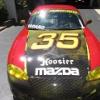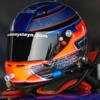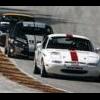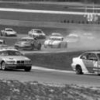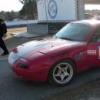
How to adjust Advanced Autosports AFP regulator?
#1

 Posted 11-24-2011 03:39 PM
Posted 11-24-2011 03:39 PM

Installed the Advance Autosports FPR on the 94 1.8 in the spring.
Since then we haved moved to another state and I have misplaced (lost) the instructions
that came with the unit.
Can someone that has the same setup remind me which screw/bolt to turn to adjust the fuel pressure,
and in which direction?
While your at it, any recommendations for an A/F ratio setting to shoot for on the 1.8? I have an Innovate guage installed also.
Thanks
Happy Thanksgiving!
Go Dolphins!


#2

 Posted 11-24-2011 07:19 PM
Posted 11-24-2011 07:19 PM

Frank
TnT Racing
SCCA Ohio Valley Region




#3

 Posted 11-24-2011 08:57 PM
Posted 11-24-2011 08:57 PM

In the front of the unit it has a nut with an allen/hex screw inside it, you losen the nut and I think you turn the hex clockwise to lean it out. I have a 99 not sure what will work for you but I run about 14 degrees timing and about 51psi.
Thanks


#4

 Posted 11-24-2011 10:22 PM
Posted 11-24-2011 10:22 PM

Ron
RAmotorsports


#5

 Posted 11-25-2011 04:19 PM
Posted 11-25-2011 04:19 PM

50-52psi seems to be the consensus, but at certain tracks where Hp is critical, you can go leaner. Where Tq is more important, go richer.
important to calibrate FP guage against known, reliable FP guage
Danny
Danny Steyn Racing | DSR YouTube Channel
Danny Steyn Photography | Adept Studios | Ocean Machinery | OPM Autosports | Rossini Racing Engines | G-Loc Brakes |
2 x SCCA Runoffs Champ | 1 x NASA National Champ | 6 x June Sprints Champ | 10 x ARRC Champ
1 x SCCA Super Sweep | 2 x Triple Crown | 4 x Hoosier Super Tour Points Champ | 6 x Majors Points Champ | 5 x SEDiv Driver of the Year











#6

 Posted 11-25-2011 05:08 PM
Posted 11-25-2011 05:08 PM

Ron - IMHO if you are running 37/38 psi then I suspect something is wrong with your FP guage. Yes you can run at that level (marginlal in my experience), but you will lose so much TQ that your car will be really slow out of the corners..
50-52psi seems to be the consensus, but at certain tracks where Hp is critical, you can go leaner. Where Tq is more important, go richer.
important to calibrate FP guage against known, reliable FP guage
'94 - '97 run at a much lower pressure than a '99. We've set ours both with and without vacuum attached and I can't remeber the numbers but mid-upper 30's is in the ballpark depending upon vacuum and idle settings. I believe clockwise increases fuel pressure. A/F reading on dyno will guide you. With a '94 you'll probably find that slightly richer after finding peak HP will be optimal as you'll be much leaner than you want to be at 4500RPM - 5500RPM when you tune only for peak. Get it near 12.6 - 12.8 between 6000 and 6900 and you'll be close. Tune from there. The next key is to figure out how to adjust the FP for weather. We find that the swing from a 50 degree day to a 90 degree day may require as much as 5PSI in adjustment and if you miss on this setting and the car is too lean, the power really suffers especially at lower RPM. An onboard AF guage is really a must IMO. Also you need to compare your on-board guage to that of the dyno. Even a 2/tenths difference between the two is meaningful. Without all this you're guessing to an extent at the track.
- Jim Drago likes this




#7

 Posted 11-25-2011 05:33 PM
Posted 11-25-2011 05:33 PM

Frank
TnT Racing
SCCA Ohio Valley Region




#8

 Posted 11-25-2011 06:39 PM
Posted 11-25-2011 06:39 PM

'94 - '97 run at a much lower pressure than a '99. We've set ours both with and without vacuum attached and I can't remeber the numbers but mid-upper 30's is in the ballpark depending upon vacuum and idle settings. I believe clockwise increases fuel pressure. A/F reading on dyno will guide you. With a '94 you'll probably find that slightly richer after finding peak HP will be optimal as you'll be much leaner than you want to be at 4500RPM - 5500RPM when you tune only for peak. Get it near 12.6 - 12.8 between 6000 and 6900 and you'll be close. Tune from there. The next key is to figure out how to adjust the FP for weather. We find that the swing from a 50 degree day to a 90 degree day may require as much as 5PSI in adjustment and if you miss on this setting and the car is too lean, the power really suffers especially at lower RPM. An onboard AF guage is really a must IMO. Also you need to compare your on-board guage to that of the dyno. Even a 2/tenths difference between the two is meaningful. Without all this you're guessing to an extent at the track.
Ditto...not a 99 Danny. I want to say stock was somewhere around 45psi? Tom, at 12.6 to 12.8 are we pushing the leanness envelope to much? My car was set at 13 and told not to go lower than that...anyone can chime in on this.
Ron
RAmotorsports


#9

 Posted 11-25-2011 06:40 PM
Posted 11-25-2011 06:40 PM

Ditto...not a 99 Danny. I want to say stock was somewhere around 45psi? Tom, at 12.6 to 12.8 are we pushing the leanness envelope to much? My car was set at 13 and told not to go lower than that...anyone can chime in on this.
The lower the number, the richer the mixture. So above 13.0 is leaner, below is richer
East Street Auto Parts
Jim@Eaststreet.com
800 700 9080













#10

 Posted 11-25-2011 08:21 PM
Posted 11-25-2011 08:21 PM

#11

 Posted 11-25-2011 10:18 PM
Posted 11-25-2011 10:18 PM

The lower the number, the richer the mixture. So above 13.0 is leaner, below is richer
Thanks Jim...guess I was not paying attention in school that day
Ron
RAmotorsports


#12

 Posted 11-25-2011 10:27 PM
Posted 11-25-2011 10:27 PM

It depends on the RPM range... in a perfect world. we would start around 12.5-12.7 at 4500 and work up to about 13.1 or 13.2 at red line.. Unfortunately our curves for the most part go the other way. They're typically leaner around 5000 and get richer at the high RPM.
On my 99 for example, 5000 is usually mid 13's and 6500-6800 is about 12.7-12.8. You have to compromise one way of the other.
- Ron Alan likes this
East Street Auto Parts
Jim@Eaststreet.com
800 700 9080













#13

 Posted 11-26-2011 12:23 AM
Posted 11-26-2011 12:23 AM

Ron
RAmotorsports


#14

 Posted 11-26-2011 12:38 AM
Posted 11-26-2011 12:38 AM

fuel pressure which richens the mixture and lowers the A/F number.
In my case the first pull showed an A/F of low 10's at 6000 RPM - too rich.
We turnd the allen screw counterclockwise to decrease FF gradually over the next 5 pulls.
HP started at 109 on first pull and reached 116.23 HP by the 6th pull with final A/F of 13.1 at 6000 RPM.
Considering we did no other changes (timing, parts swaps etc) I was pretty happy with my first dyno tune experience.
I also got a cool set of charts with different color lines on them to puzzle over.
Thanks again for all the input.


#15

 Posted 11-26-2011 01:12 AM
Posted 11-26-2011 01:12 AM

Back from the dyno this morning. As reported here turning the screw clockwise increases
fuel pressure which richens the mixture and lowers the A/F number.
In my case the first pull showed an A/F of low 10's at 6000 RPM - too rich.
We turnd the allen screw counterclockwise to decrease FF gradually over the next 5 pulls.
HP started at 109 on first pull and reached 116.23 HP by the 6th pull with final A/F of 13.1 at 6000 RPM.
Considering we did no other changes (timing, parts swaps etc) I was pretty happy with my first dyno tune experience.
I also got a cool set of charts with different color lines on them to puzzle over.
Thanks again for all the input.
Based on your numbers it sounds like you got our chart
Ron
RAmotorsports


#16

 Posted 11-26-2011 09:14 AM
Posted 11-26-2011 09:14 AM

Back from the dyno this morning. As reported here turning the screw clockwise increases
fuel pressure which richens the mixture and lowers the A/F number.
In my case the first pull showed an A/F of low 10's at 6000 RPM - too rich.
We turnd the allen screw counterclockwise to decrease FF gradually over the next 5 pulls.
HP started at 109 on first pull and reached 116.23 HP by the 6th pull with final A/F of 13.1 at 6000 RPM.
Considering we did no other changes (timing, parts swaps etc) I was pretty happy with my first dyno tune experience.
I also got a cool set of charts with different color lines on them to puzzle over.
Thanks again for all the input.
The fact that you got 7HP is pretty awesome
And your experience pretty much explains why so many of us use the dyno so extensively - in a "spec" class there is so much to be had by tuning and tweaking on the dyno. My "AHAH moment" came at the the 2010 runoffs watching Gorilla book the track dyno before every qalifying and race session (weather conditions change on the hour at Road America in Sept) and DDG religiously on the dyno before each session switching out AFM and other sensors trying to get the most out of the car.
Danny
Danny Steyn Racing | DSR YouTube Channel
Danny Steyn Photography | Adept Studios | Ocean Machinery | OPM Autosports | Rossini Racing Engines | G-Loc Brakes |
2 x SCCA Runoffs Champ | 1 x NASA National Champ | 6 x June Sprints Champ | 10 x ARRC Champ
1 x SCCA Super Sweep | 2 x Triple Crown | 4 x Hoosier Super Tour Points Champ | 6 x Majors Points Champ | 5 x SEDiv Driver of the Year











#17

 Posted 11-26-2011 01:42 PM
Posted 11-26-2011 01:42 PM

Thanks Jim...guess I was not paying attention in school that day
Actually I realize now my memory is faulty...we started at a higher number and he said we need to come down...which we did and it was to much so he went back up. I just remember the 12.9-13.0 range. What A/F ratio would you consider to lean in the power band? Tom...your comment on temp makes sense. Will the car go leaner or richer as the temp increases? I would assume altitude would also affect this?
My car gets richer on cooler days so we have to reduce FP comapred to warmer days, but it's not a perfectly linear excercise. Humidity I think also plays a role but we haven't got a good handle on that yet. In the past when we couldn't adjust we simply ran the car and on some days you got good A/F numbers and on other days you didn't. Now you can drive yourself nuts adjusting for each session as a day gets warmer or cooler and if you don't have a good idea how to adjust for conditions BEFORE YOU GET ON TRACK it's too late. I think the '94 - '95 has the worst engine management among all the cars so it's the most challenging to dial in for conditions and the A/F curve varies more top to bottom than the other cars even when adjusted as best it can be.




#18

 Posted 11-26-2011 10:10 PM
Posted 11-26-2011 10:10 PM

My car gets richer on cooler days so we have to reduce FP comapred to warmer days, but it's not a perfectly linear excercise. Humidity I think also plays a role but we haven't got a good handle on that yet. In the past when we couldn't adjust we simply ran the car and on some days you got good A/F numbers and on other days you didn't. Now you can drive yourself nuts adjusting for each session as a day gets warmer or cooler and if you don't have a good idea how to adjust for conditions BEFORE YOU GET ON TRACK it's too late. I think the '94 - '95 has the worst engine management among all the cars so it's the most challenging to dial in for conditions and the A/F curve varies more top to bottom than the other cars even when adjusted as best it can be.
So lets say you dyno at 70 degrees, if you get to the track and it is 45 degrees, odds are you will be running rich...leaner if it is 100 degrees out...correct? So in theory, if you dyno on a really cold day and a month later run the car on a really hot day(maybe 60 degree swing)could you run lean enough to hurt the car?
Ron
RAmotorsports


#19

 Posted 11-26-2011 11:02 PM
Posted 11-26-2011 11:02 PM

Unless it's different on this coast.
The dyno allows you to set the "best" a/f ratio under those conditions. You need to adjust for conditions at the track that day. To do that you need a wide band O2 sensor and you need to have calibrated it before the dyno run and observed it during the run. Adjusting the a/f at the track takes a few seconds and is really helpful when the temperature swings are significant, like in the Spring & Fall. It's a pretty worthless exercise without the O2 sensor.


#20

 Posted 11-26-2011 11:28 PM
Posted 11-26-2011 11:28 PM

Ron
RAmotorsports


1 user(s) are reading this topic
0 members, 1 guests, 0 anonymous users




 Sign In
Sign In Create Account
Create Account



 Back to top
Back to top Report
Report
